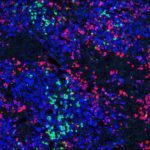Lien vers Pubmed [PMID] – 19061838
Cancer Cell 2008 Dec;14(6):471-84
Hepatoblastoma, the most common pediatric liver cancer, is tightly linked to excessive Wnt/beta-catenin signaling. Here, we used microarray analysis to identify two tumor subclasses resembling distinct phases of liver development and a discriminating 16-gene signature. beta-catenin activated different transcriptional programs in the two tumor types, with distinctive expression of hepatic stem/progenitor markers in immature tumors. This highly proliferating subclass was typified by gains of chromosomes 8q and 2p and upregulated Myc signaling. Myc-induced hepatoblastoma-like tumors in mice strikingly resembled the human immature subtype, and Myc downregulation in hepatoblastoma cells impaired tumorigenesis in vivo. Remarkably, the 16-gene signature discriminated invasive and metastatic hepatoblastomas and predicted prognosis with high accuracy.


